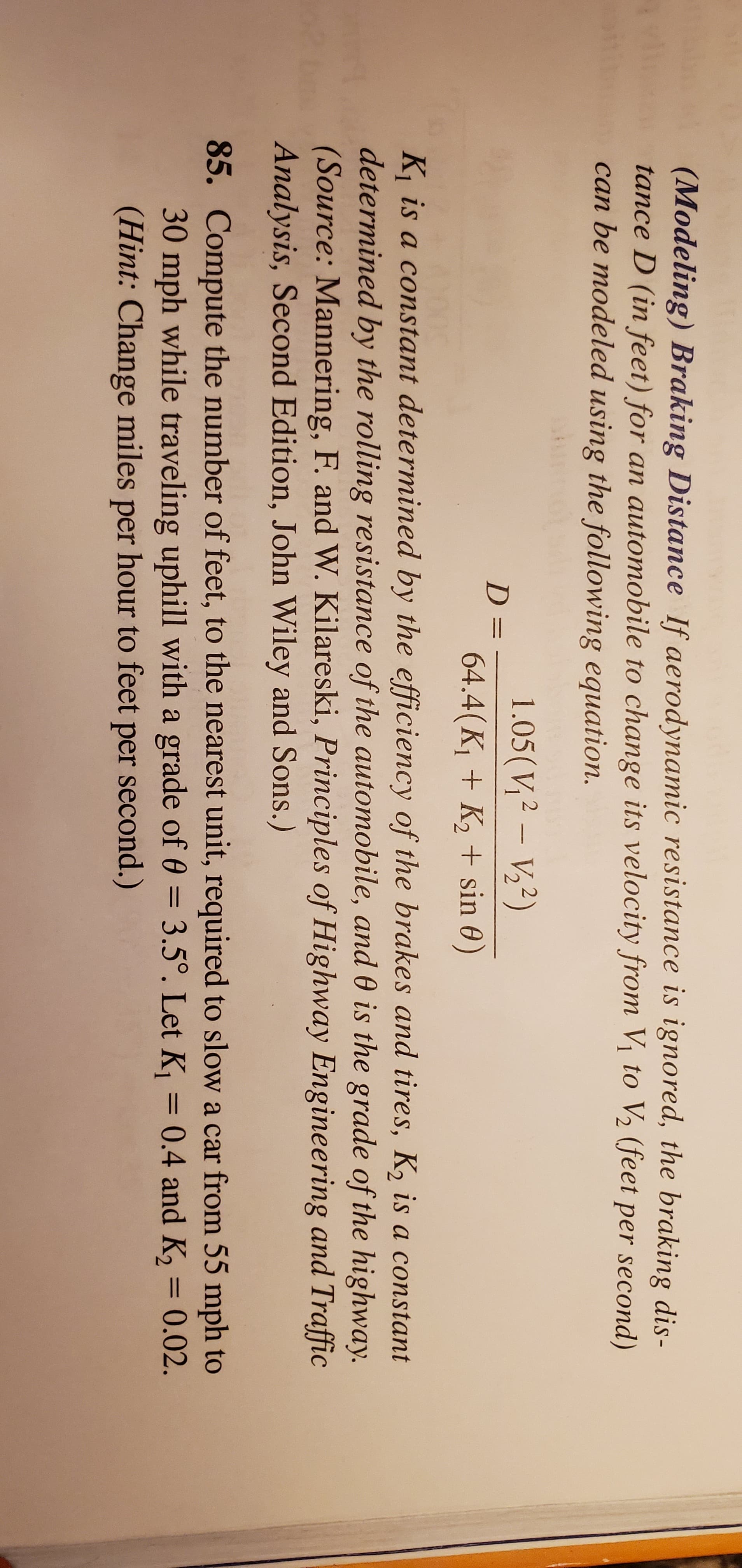(Modeling) Braking Distance If aerodynamic resistance is ignored, the braking dis- tance D (in feet) for an automobile to change its velocity from Vị to V½ (feet per second) can be modeled using the following equation. 1.05(V,2 – V,2) %3D 64.4(K + K2 + sin 0) K is a constant determined by the efficiency of the brakes and tires, K is a constant determined by the rolling resistance of the automobile, and 0 is the grade of the highway. (Source: Mannering, F. and W. Kilareski, Principles of Highway Engineering and Traffic Analysis, Second Edition, John Wiley and Sons.) 85. Compute the number of feet, to the nearest unit, required to slow a car from 55 mph to 30 mph while traveling uphill with a grade of 0 = 3.5°. Let K = 0.4 and K, = 0.02. (Hint: Change miles per hour to feet per second.) %3D
(Modeling) Braking Distance If aerodynamic resistance is ignored, the braking dis- tance D (in feet) for an automobile to change its velocity from Vị to V½ (feet per second) can be modeled using the following equation. 1.05(V,2 – V,2) %3D 64.4(K + K2 + sin 0) K is a constant determined by the efficiency of the brakes and tires, K is a constant determined by the rolling resistance of the automobile, and 0 is the grade of the highway. (Source: Mannering, F. and W. Kilareski, Principles of Highway Engineering and Traffic Analysis, Second Edition, John Wiley and Sons.) 85. Compute the number of feet, to the nearest unit, required to slow a car from 55 mph to 30 mph while traveling uphill with a grade of 0 = 3.5°. Let K = 0.4 and K, = 0.02. (Hint: Change miles per hour to feet per second.) %3D
Principles of Heat Transfer (Activate Learning with these NEW titles from Engineering!)
8th Edition
ISBN:9781305387102
Author:Kreith, Frank; Manglik, Raj M.
Publisher:Kreith, Frank; Manglik, Raj M.
Chapter5: Analysis Of Convection Heat Transfer
Section: Chapter Questions
Problem 5.2P: 5.2 Evaluate the Prandtl number from the following data: , .
Related questions
Question
Compute the number of feet, to the nearest unit, require to slow a car from 55 mph to 30 mph while traveling uphill with a grade of theta=3.5°. Let k1= 0.4 and k2= 0.02 (hint: change miles per hour to feet per second.)

Transcribed Image Text:(Modeling) Braking Distance If aerodynamic resistance is ignored, the braking dis-
tance D (in feet) for an automobile to change its velocity from Vị to V½ (feet per second)
can be modeled using the following equation.
1.05(V,2 – V,2)
%3D
64.4(K + K2 + sin 0)
K is a constant determined by the efficiency of the brakes and tires, K is a constant
determined by the rolling resistance of the automobile, and 0 is the grade of the highway.
(Source: Mannering, F. and W. Kilareski, Principles of Highway Engineering and Traffic
Analysis, Second Edition, John Wiley and Sons.)
85. Compute the number of feet, to the nearest unit, required to slow a car from 55 mph to
30 mph while traveling uphill with a grade of 0 = 3.5°. Let K = 0.4 and K, = 0.02.
(Hint: Change miles per hour to feet per second.)
%3D
Expert Solution
This question has been solved!
Explore an expertly crafted, step-by-step solution for a thorough understanding of key concepts.
This is a popular solution!
Trending now
This is a popular solution!
Step by step
Solved in 2 steps with 1 images

Knowledge Booster
Learn more about
Need a deep-dive on the concept behind this application? Look no further. Learn more about this topic, mechanical-engineering and related others by exploring similar questions and additional content below.Recommended textbooks for you

Principles of Heat Transfer (Activate Learning wi…
Mechanical Engineering
ISBN:
9781305387102
Author:
Kreith, Frank; Manglik, Raj M.
Publisher:
Cengage Learning

Principles of Heat Transfer (Activate Learning wi…
Mechanical Engineering
ISBN:
9781305387102
Author:
Kreith, Frank; Manglik, Raj M.
Publisher:
Cengage Learning